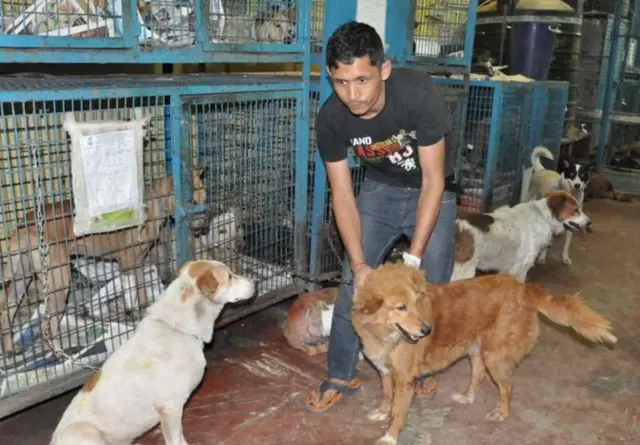Cruelty to animals in India is a concern which Indians appear not ready to take responsibility for, with attacks on stray animals, especially dogs, becoming part of daily life.
In the capital New Delhi, an unidentified man was caught on CCTV attacking a dog and killing a puppy outside a metro station. A housewife in the southern state of Karnataka smashed eight puppies on a boulder. In the northern state of Uttar Pradesh, a man in an inebriated state poured acid on five new born puppies and their mother. The west central state of Maharashtra registered a case in which a traffic police officer was arrested for the brutal assault on a stray dog, which led to permanent blindness in one eye. Around 50 community dogs were sedated with food laced with pesticide and then burned alive in the south-eastern state of Tamil Nadu.
All these incidents took place within the span of a month, with the last one occurring recently.
“In Hindu culture, we are taught that the same soul that is in a human being is the same in all animals. It is also an animate thing, so we have to treat everything equally. Thus we have to treat all the animals with grave respect,” explains Geeta Seshamani, 65, vice-president of New Delhi’s Friendicoes SECA, a non-governmental organisation working to protect stray animals.
There is no central agency where all these cases can be documented, but NGOs including People for the Ethical Treatment of Animals, People for Animals, Friendicoes and certain welfare organisations report constant complaints regarding animal cruelty.
“The problem is faced by all developing countries about what to do with the large number of scavenging animals on the roads. It’s not a kind of problem which has been created by nature,” says Gauri Maulekhi, trustee from the New Delhi-based NGO People for Animals.
Like several other countries around the world, hurting animals in India is also considered a punishable offence. But the lack of effective laws indirectly encourages the occurrence of such tragic incidents. The maximum punishment under the Prevention of Cruelty to Animals Act of 1960 is a fine of 50 rupees (about US 70 cents) or imprisonment up to three months or both.
Cruelty to animals has no place in modern medical schools
When compared to the West, it is apparent how urgent it is for the law to be revised. In the United States, acts of cruelty against animals are now counted in the FBI’s criminal database. In Australia, the maximum penalty for animal cruelty offences is a five-year prison term and a fine of A$50,000 (US$36,000) for individuals and A$250,000 for corporations.
Maulekhi says Indians incur the penalty as a joke, which clearly implies that they have no responsibility towards protecting animals.
“Prevention of cruelty to animals came in 1960, but the penalties have not been revised for the last 50 years. We are pushing the government hard to revise the penalties now because these few attacks which have taken place recently have kind of acted like a catalyst in this entire movement, so we are just waiting for its implementation,” she adds.
The increase in the population of stray dogs has made the situation worse. Dog bites are one of the common issues in residential areas and a big reason behind cruelty inflicted on them.
Ajit, a civilian who hails from New Delhi, suggests that stray dogs are part of society and therefore should be protected by the government in order to mitigate cruelty toward them.
“The government must start rescuing the animal birth control centres because population control is the only way. They must open up space for rescuing and keeping the diseased and sick animals,” he said.
In late 2015, the government in the southern state of Kerala also mulled cracking down on stray dogs after claiming that dog-bite incidents in the state had risen to more than 100,000 a year. A mass protest followed an incident in which more than 40 dogs were allegedly killed. The Supreme Court later directed all states to sterilise and vaccinate stray dogs under the supervision of the Animal Welfare Board of India.
Are you contributing to animal abuse? Attractions to avoid on your next holiday
“The policy of the Animal Welfare Board of India, all NGOs and organisations like ours is to work in such a way that we can make life safe, healthy and comfortable for these animals but also for the public, which is why our national programme is to sterilise and vaccinate, which is called the Animal Birth Control Programme, and it has been scientifically proven that the most humane and effective way of controlling birth of animals is through sterilisation,” says Geeta Seshamani of Friendicoes.
Cruelty is not limited to attacks. According to animal activists, abandonment of pets is also one of the reasons for the increase in the stray dog population. Gauri Maulekhi of People for Animals says, “Abandonment is a huge issue. Irresponsible pet ownership adds a huge amount of burden on the already existing huge population of street dogs. A lot of people think that dogs are just a matter of convenience, you can keep them for as long as you like them and leave them whenever you want.”
However, the animal activists are working hard to make people aware of the misdeeds taking place in the community. They are also of the opinion that the government should take certain steps toward improving the situation.
Seshamani adds, “We need to call for holistic town planning. We have to plan for dog walking paths. I do not know how much attention is being paid to it.”
(AP)
 简体中文
简体中文

